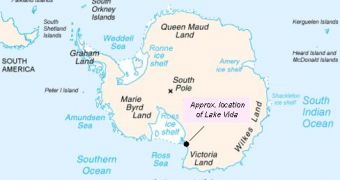Lake Vida is, arguably, one of the most peculiar places on the planet, and also one of the places where you don't expect to find any life whatsoever. Located some 60 feet under the ice sheet in Southern Antarctica, the lake is, in fact, an ice bottle of brine, a geological curiosity, experts say. However, when the site was first investigated in 2002, researchers discovered there colonies of the oldest and coldest living organisms on Earth. For example, living cryobiological microbes some 2,800 years old were found, and then gradually brought back to life in the lab.
The investigation raised many eyebrows, as many scientists were amazed by the wealth of information that the lake brought into the community. The US National Science Foundation (NSF) also took a keen interest in exploring the geological formation, and recently awarded $1.1 million for a second drilling expedition to the location. The new studies will be conducted by University of Illinois in Chicago (UIC) Associate Professor of Earth and Environmental Sciences Peter Doran, who is also the author of the 2002 discovery. Experts from the Nevada-based Desert Research Institute will join the crew too.
“The main goal is to get into that brine pocket and the sediment beneath it to both document and define the ecosystem that's there today, and the history of that ecosystem,” Doran explains. The team plans to drill directly through Lake Vida's thick ice cap, through the brine lake, and then further down another ten feet, in the layer of deposits underneath. The soil and ice samples that will be extracted during this expedition will hopefully help scientists get a better insight into how the Earth's climate looked like millennia ago. They could also pinpoint factors that allowed for cryobiological microbes to survive.
“If we took, for example, a Wisconsin lake and started turning the temperatures down during a climatic downturn, what is the impact on the lake's ecosystem and what strategies are used by living things to survive this extremely cold brine? There are few examples on Earth of things shown to live in that water temperature,” Doran adds. He says that the salty liquid under the Antarctic surface hovers around 10 degrees Fahrenheit all year round, and that its salt concentration is five to seven times that of ocean waters.

 14 DAY TRIAL //
14 DAY TRIAL //